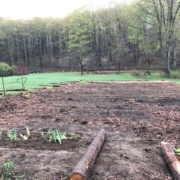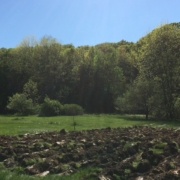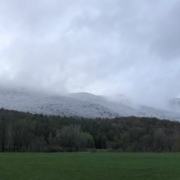If, by chance,
you found a baby barred owl hatchling in the grass beneath a nest that was 30-feet-up in a dead white pine — way too high to climb — you might find a nearby tree cavity that you could reach and stow the little one in there. Feed it freshly trapped, chopped-up mice. Wait for the parents to locate it and take over the feeding themselves.
Turning a Patch of Lawn into a Vegetable Garden, Part 2
Year two of the garden project started with a decision: was I going to keep using a tractor to work the earth?
Like many of you, I grew up thinking that you needed to deeply till the soil to grow things in it. As a boy, I remember being beat up by the family roto-tiller, the thing pitching me around like a bull as I tried to hang on to it. In my twenties I worked on a vegetable farm, and we basically used the same techniques as we used in the home garden, just with better equipment. Every spring, we broke the earth with a three-bottom plow. We then disked, then spread manure, then used a tractor-mounted tiller to make fluffy beds. The soil was so soft and loose when you were done that you wanted to lay down and take a nap in it.
Of course the downside to soft, loose dirt is that there’s no structure anymore, which leaves the soil vulnerable. Without a plant layer to act as a roof, topsoil can dry out and blow away, rain water gushes in instead of trickling in, ecosystems full of mycorrhizae and microbes and insect life get all smashed up. A no-till farming/gardening advocate would tell you that the plow is a pariah, and best practice involves keeping dirt as green as possible for as long as possible, then work only the top few inches of soil, leaving the subsoil as intact as possible.
We want to dig deeply into the topic of soil in Volume II of the Almanac, talk to some growers with different perspectives on best practice and report what we hear. My sense is that it’s not a case of right or wrong, it’s a matter of scale, technique, available resources, and what trade-offs you’re prepared to make.
In the meantime, where it comes to this garden, I decided to pursue a modified no-dig approach. Instead of plowing and disking this year, I simply scratched the soil surface with a York rake to break up the dead buckwheat litter. I blew my budget by investing $100 in a broadfork – basically a pitchfork on steroids that lifts compacted soil. And I borrowed a twist tiller, which is a tool you plunge into the earth and twist to break up a planting bed. If the hand tools work, I’ll be able to recoup much of the cost by selling the old roto-tiller that sits in my garage.
Turning a Patch of Lawn into a Vegetable Garden, Part 1
Like many people, I decided to start a big vegetable garden in the Covid spring of 2020. The goal was a garden on the cheap – a couple hundred bucks was the rough budget agreement with my partner.
I went the traditional rectangle-on-the-ground route, as opposed to raised beds, because I didn’t want to have to buy or make lumber and I didn’t want to have to dig and elevate soil. I’m blessed with a big backyard so space isn’t an issue. I know the ground is fertile because I had it tested at UVM: here’s the link to follow if you want to do that with your own soil. For $15 they’ll send you back an analysis that tells you what it has and what it needs; for a few dollars more they’ll test for heavy metals.
To break the earth, I borrowed a tractor and hooked it up to an old trip plow and a set of disks that came out of a hedgerow. I believe the plow was a model called “Little Wonder” that was made by International Harvester in the early part of the 20th century. Hopefully there’s an equipment collector reading this who can correct me if I’m wrong on my ID.
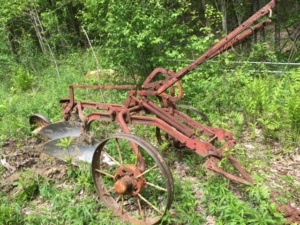
The old plow was elegant; even after years of rust and disuse it worked like a charm. I plowed with my three-year-old daughter, and as you can see from the picture, it was slow going, since we needed to get off and pull worms out of the furrows with each pass.
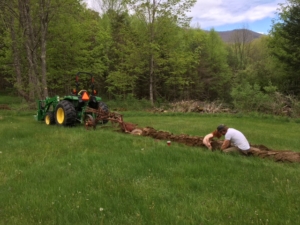
The rectangle ended up being about 30 x 70, which seemed right. The thinking here was that if I’m going to go through all the trouble of putting up a deer fence, it may as well fence in a large area. A big footprint will give me the ability to scale up or scale down based on the time and interest available in any given year. And if it turns out to be too big to manage, then I’ll plant some fruit trees within the fence, or keep animals in there.
If I didn’t have access to heavy equipment, I might have tried weakening the sod with landscape fabric, then smothering it with cardboard and mulch for a year. This fits into the no-dig garden concept that’s all the rage amidst a certain subset of home gardeners. I’m intrigued by no-dig techniques, especially by the idea that you’re not using machines to compact your soil, and you’re not exposing more bare dirt than you need. On a small scale it makes a lot of sense to me. But the logistics of trying to do a 2,000 square foot garden this way were too daunting. Plus we all work with what we have, and in my case it’s easier to borrow a tractor and coax some old machinery to life than it is to try to source industrial rolls of cardboard and gobs of mulch.
In year 1, after breaking the earth with a plow and disking it, I mostly resisted the temptation to start planting and instead cover cropped for a year. Lawn sod takes a long time to break down. And the soils under lawns are compacted, which plants don’t like. And there are white grubs, and crabgrass, and other garden pests that get stirred up by disturbance but can be blunted with time and technique.
To cover the exposed soil I planted buckwheat, which is cheap. It took maybe $10 worth of seed to cover the rectangle. Buckwheat grows fast, so it’s a good smother crop which keeps the weeds down. It has deep roots, which helps loosen the compacted soil. It can add phosphorous to the soil, but since I just let it die and fall over, I probably missed this benefit. Still, the dead thatch protected the soil all winter, and in the spring of 2021 I had a nice, loose rectangle of earth to work.
The story continues in Part 2 of the blog . . .
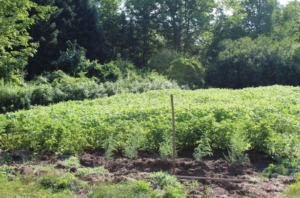
The garden plot in late July, 2020



